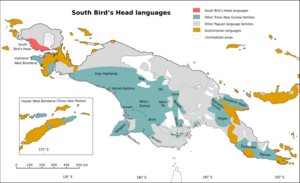Social:South Bird's Head languages
| South Bird's Head | |
|---|---|
| South Doberai North Berau Gulf | |
| (disputed) | |
| Geographic distribution | West Irian Jaya |
| Linguistic classification | ? Trans–New Guinea
|
| Subdivisions |
|
| Glottolog | None sout1516 (South Bird's Head proper)[1] kond1302 (Konda–Yahadian)[2] inan1242 (Inanwatan)[3] |
 Map: The South Bird's Head languages of New Guinea
The South Bird's Head languages
Other Trans–New Guinea languages
Other Papuan languages
Austronesian languages
Uninhabited | |
The South Bird's Head or South Doberai languages are three families of Papuan languages. They form part of the Trans–New Guinea languages in the classification of Malcolm Ross (2005), although Pawley and Hammarström (2018) do not consider them to be part of Trans–New Guinea.[4]
Languages
The languages are as follows,[5][4]
- Konda-Yahadian (Yabin): Konda, Yahadian
- Inanwatan (Western): Duriankere, Inanwatan (Suabo)
- South Bird's Head proper (Nuclear South Bird's Head):
- East South Bird's Head:
- Kemberano (Weriagar, Barau)
- Arandai (Dombano) [dialect cluster]
- Kokoda (Tarof, Kasuweri)
- Kaburi
- Kais (Kampong Baru)
- Puragi (Iwaro)
- East South Bird's Head:
Noting low cognacy rates, Holton and Klamer (2018) tentatively consider the following three language groups to each be independent language families, pending further evidence.[6]
Usher classifies the South Bird's Head languages as part of a wider Berau Gulf family.[7]
Pronouns
The pronouns are:
sg pl 1ex *na *ni-ri, *i-ri 1in *na-ri, *ya-ri 2 *a *a-ri, *i-ri
3sg *ni is reconstructable for SBH proper. There appears to be both a plural vowel change from *a to *i, as in proto-TNG, and a plural suffix *-ri.
Cognates
Below are cognates in Nuclear South Bird's Head languages (Arandai, Kokoda, Kemberano, Kaburi, Kais, Puragi) demonstrating their relatedness, as listed by Holton & Klamer (2018):[6]
Nuclear South Bird's Head family cognates gloss Arandai Kokoda Kemberano Kaburi Kais Puragi ‘eye’ emago mago magu amiagu magu imagu ‘head’ kabe kaba kabe wa’ava kabo koibi ‘egg’ kuo ukwo oku uko uku vuko ‘one’ onate onasia anate ma’aja onate mo’onata ‘two’ ogi ogia oge uge uge oge ‘I’ nendi nedi nedi neri neri nedi
South Bird's Head basic vocabulary quoted by Holton & Klamer (2018)[6] from de Vries (2004), showing diverse non-cognate vocabulary across different language groups:[8]
South Bird's Head basic vocabulary comparison gloss Yahadian Inanwatan Kokoda Puragi arm/hand re ewó obora nebɔru leg/foot dɛbɛ ɔtɔra neʔɔru house ɔ meʔáro kɛnia einɔ good hɔbɔre sówato nigeja nai/najɔ dog ɟia méwoʔo dawɔra rɔga pig mɔmɔ bidó tabai βuʔi chicken kokoro ádiro koko korau louse nɔ ʔóto kɔnɔ kɔnɔ water/river hɛdɛ/mu tó/múro tai/tɔiria adɔna/ɔwedi banana huŋgunɔn ɸúgi(do) udi amimi
Morphology
Except for the outlier languages Konda and Yahadian, all South Bird's Head languages have nouns classified according to masculine and feminine genders, which are determined with final vowel quality.[6] West Bird's Head languages also mark nouns for gender.
Syntax
Unlike many other languages of the Bird's Head Peninsula which display SVO word order (such as Abun, Mpur, Maibrat, West Bird's Head, and others), the South Bird's Head languages have SOV word order.[6]:588-590
References
- ↑ Hammarström, Harald; Forkel, Robert; Haspelmath, Martin, eds (2017). "South Bird's Head Family". Glottolog 3.0. Jena, Germany: Max Planck Institute for the Science of Human History. http://glottolog.org/resource/languoid/id/sout1516.
- ↑ Hammarström, Harald; Forkel, Robert; Haspelmath, Martin, eds (2017). "Konda–Yahadian". Glottolog 3.0. Jena, Germany: Max Planck Institute for the Science of Human History. http://glottolog.org/resource/languoid/id/kond1302.
- ↑ Hammarström, Harald; Forkel, Robert; Haspelmath, Martin, eds (2017). "Inanwatan". Glottolog 3.0. Jena, Germany: Max Planck Institute for the Science of Human History. http://glottolog.org/resource/languoid/id/inan1242.
- ↑ Jump up to: 4.0 4.1 Pawley, Andrew; Hammarström, Harald (2018). "The Trans New Guinea family". in Palmer, Bill. The Languages and Linguistics of the New Guinea Area: A Comprehensive Guide. The World of Linguistics. 4. Berlin: De Gruyter Mouton. pp. 21-196. ISBN 978-3-11-028642-7.
- ↑ Hammarström, Harald; Forkel, Robert; Haspelmath, Martin, eds (2019). "Glottolog". Jena: Max Planck Institute for the Science of Human History. https://glottolog.org.
- ↑ Jump up to: 6.0 6.1 6.2 6.3 6.4 Holton, Gary; Klamer, Marian (2018). "The Papuan languages of East Nusantara and the Bird’s Head". in Palmer, Bill. The Languages and Linguistics of the New Guinea Area: A Comprehensive Guide. The World of Linguistics. 4. Berlin: De Gruyter Mouton. pp. 569-640. ISBN 978-3-11-028642-7.
- ↑ Usher, Timothy. New Guinea World, North Berau Gulf
- ↑ de Vries, Lourens. 2004. A Short Grammar of Inanwatan: An endangered language of the Bird’s Head of Papua, Indonesia. Canberra: Pacific Linguistics.
- Ross, Malcolm (2005). "Pronouns as a preliminary diagnostic for grouping Papuan languages". in Andrew Pawley. Papuan pasts: cultural, linguistic and biological histories of Papuan-speaking peoples. Canberra: Pacific Linguistics. pp. 15–66. ISBN 0858835622. OCLC 67292782.

